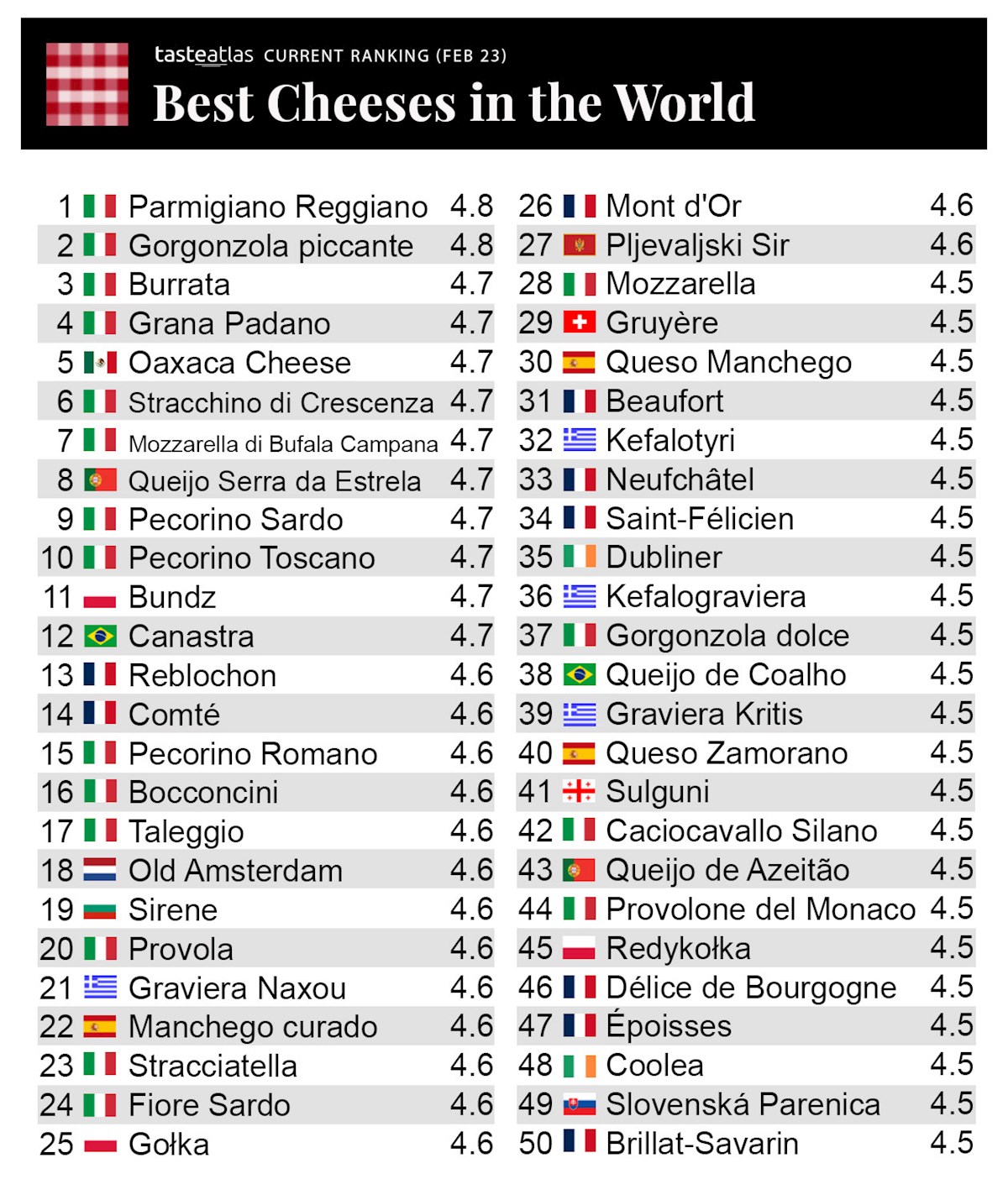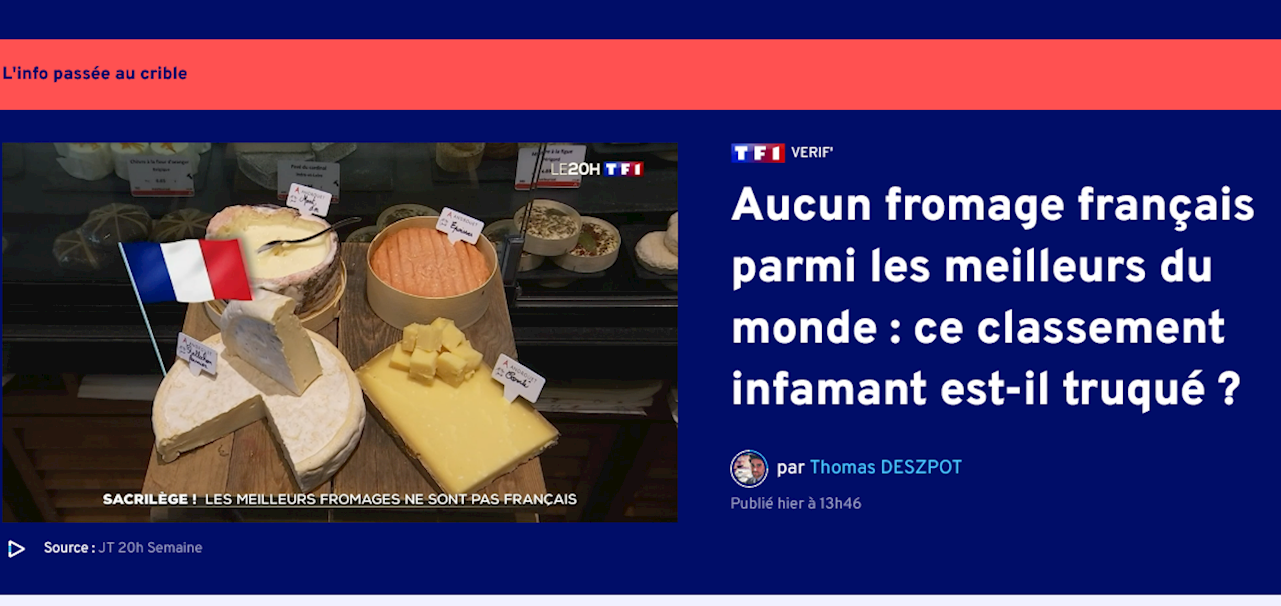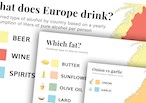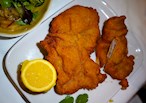Five days ago, the updated TasteAtlas ranking of cheeses was published. Parmigiano Reggiano took the first spot, and among the first ten spots, as many as eight cheeses are Italian. The best non-Italian cheeses are Mexican Oaxaca (#5) and Portuguese Estrela (#8), followed by Polish and Brazilian cheeses. French Reblochon and Comté take 13th and 14th place.

Hundreds of media around the world have reported on the cheese ranking update. Some received the ranking with enthusiasm, some with surprise, and some with indignation. The most-watched French TV channel TF1 is among those who took it to heart. TF1 asks accusingly in the title, "Is the ranking rigged?". The author also notes that TasteAtlas is not open and transparent about its rankings, even though we explained the entire methodology to the TF1 journalist Thomas Deszpot and mentioned that we are open to any additional questions, of which there were none.
We understand French national pride, and we love and have great respect for French food, so we will not be offended by these harsh words. After all, what should a person be passionate about but cheese?!
Therefore, instead of being offended by the accusations, we will once again try to explain the idea of TasteAtlas and the methodology of our rankings.
Idea of TasteAtlas and ranking
TasteAtlas is a world food atlas. The idea is to provide information about the best local dishes and ingredients around the world.
More precisely, the idea is to catalog all traditional foods of the world, to promote the idea of eating local and getting to know local cultures, to record and save from oblivion authentic ancient recipes, and to celebrate and promote restaurants that offer excellent, quality, honest, and normal, traditional food. That is, in the restaurant segment, to be something like a reverse, no-bullshit Michelin. Celebrating the flavors, not the show. So far, we have reached 15+ thousand cataloged foods, and we plan to continue until we have recorded all in every corner of the world, whether in this life or the next.
The basic idea of the rankings we constantly publish is to arouse visitors' curiosity and interest in various foods. Rankings awaken passion, which is a good way to pique interest. If such rankings will take someone to Oaxaca to try the fifth-best cheese in the world or to Indonesia to try the best deep-fried dessert in the world, great. They will take some even to Siberian Sakha to try the worst-rated dish in the world.
Italian dishes, ingredients, and beverages are at the top of many of our rankings. Why? TasteAtlas is a project started in Croatia, none of our authors are Italian, and most of our visitors are American and British. The explanation may be hard for many to swallow: people love Italian food.
Methodology
The methodology of TasteAtlas is seemingly simple. Visitors vote, and we tally the votes and publish the rankings.
Our key mechanism is a system we developed that differentiates genuine from invalid votes. We track the visitor's behavior on our web, we track all his ratings, and depending on whether the system recognizes him as a real visitor or as a nationalist or a bot, his votes are recognized or ignored. You can't visit TasteAtlas, slap fives and fours on Italian cheeses, ones and twos on French, and expect your votes to count. You can't come to TasteAtlas, give a few ratings, and expect your votes to be valid.

A week ago, we published a ranking of the worst dishes in the world. The first place was taken by Indigirka, a salad made from pieces of frozen fish from Siberia. The Russian Ministry of Foreign Affairs visited Siberia to taste the salad, and dozens of Russian media and bloggers furiously reported on our ranking. And hundreds of people who have never even tried it came to TasteAtlas to give Indigirka five stars. Only one vote was accepted as valid that day. But that one really counts.
It is hardly possible to manipulate the results, and if we discover the manipulation, we add a new mechanism to prevent it.
In love with food of the world
If you have a purely nationalistic approach to food, don't follow us, don't vote, and don't visit us. If you want to help others to discover great dishes you've tried, help promote cultures and local cuisines you love, if you can accept that some dishes of the world are loved by others more than the ones you prefer, you will accept TasteAtlas as a neutral platform in love with local food from all over the world, just as you are.
TasteAtlas is a platform for normal food and down-to-earth people. No haute cuisine, no modern twists, no fuss. Perhaps part of the explanation for our rankings may lie exactly in that: our audience may recognize Italian food, or at least the branding of Italian food, as more down to earth and less pretentious than French.
We love French food. But if French foods are doing a bit worse in popular opinion at the moment, it might be more useful if they ask themselves what they are doing wrong with their marketing and promotion of their food in times when more and more people are not looking for theater and show while eating, but simply great flavors.




